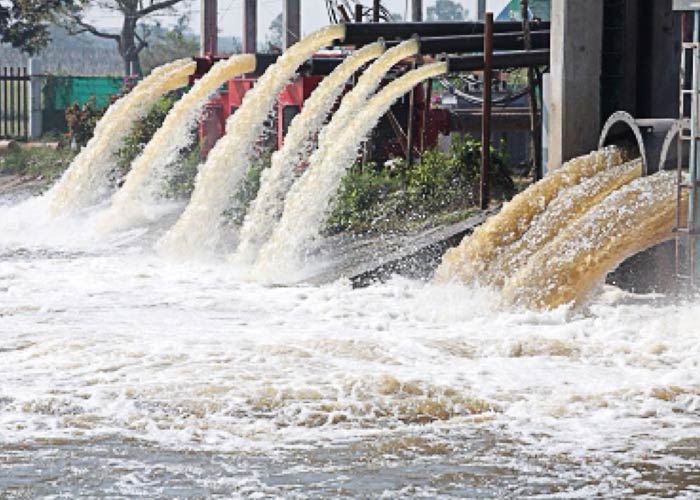Meaning and Implications of Urbanization
Urbanization has become very common in developing as well as developed countries. It is a process wherein general people migrate from rural to urban area in search of brighter social as well as economic feasibilities such as better education, good health care, proper sanitation, comfortable housing, immense business opportunities and versatile transportation. Urbanization is a gradual process, which is influenced by various economic, political and geographical factors.
Broadly, urbanization refers to the growth of towns and cities as people move from rural areas to urban centres with a hope to lead a better life. These days, the percentage of total population living in urban areas is increasing in most of the countries of the world. Hence, urbanization can also be termed as the progressive increase in thenumber of people living in towns and cities.
Urbanization has become one of the common features of economic development in the world. As urbanization and economic development are closely associated, the economic development of a country indicates enhancement in the level of per capita income and standard of living of its growing population. The process of urbanization depends on the shift of surplus population from rural to urban areas along with the gradual growth of some industrialized urban centres. Due to social and economic pressures, people from backward villages tend to move towards urban areas in search of jobs as newly established industries and ancillary activities offer more job opportunities to the people migrating to cities. The pace of urbanization provided by the industrial growth is fast but gradually it starts declining when the proportion of urban population to total population of the country becomes very high.
Causes of Urbanization
The major cause of urbanization is a rapid movement of people towards cities and towns as they view the rural areas as places with hardship, backwardness or primitive lifestyle. Therefore, when large populations move to more developed areas like towns and cities, it leads to the phenomena of urbanization.
We can classify the causes of urbanization as follows:
- Industrialization: There is a trend representing a shift from the old agricultural practices to non-agricultural jobs creating a modernized society. In recent past, an increasing number of people have been attracted to move from rural to urban areas for better employment opportunities riding on industrial revolution. People have got the chance to work in various industrial sectors to stir the economic development.
- Commercialization: All types of trades contribute immensely to urbanization. In the modern era, the distribution of goods, services and commercial transactions have developed many modern marketing institutions and exchange methods resulting in the rapid growth of towns and cities. It is a general perception in people’s mind that commercialization and trade in towns and cities offer better opportunities as well as returns as compared to rural areas.
- Social benefits: There are numerous social benefits attributed to life in cities and towns. People get better facilities in urban area like educational, sanitation, housing, health care, recreation and living standards to lead a good social life in general. Due to these reasons, more and more people are prompted to migrate into cities and towns to obtain a wide variety of social benefits and services which are not presently available in rural areas.
- Employment opportunities: Ample job opportunities are there in urban areas that certainly attract people living in rural areas to seek better livelihood. Because of this reason people frequently migrate into urban areas in search of well-paying jobs in developmental sectors such as public health, education, transport, sports, recreation and business enterprises. Higher value-added jobs are being generated by such services as well as industries leading to more employment opportunities in urban areas.
- Modernization and changed lifestyle: Modernization and drastic change in today’s lifestyle of people plays a very important role in the process of urbanization. Now-a-days urban areas are becoming more technology savvy with a highly sophisticated communication, infrastructure, medical facilities, dressing code, enlightenment, liberalization and social amenities availability.Most of the people have the view in their minds that they can lead a better and happy life in cities. As a result people are migrating towards the cities and the cities are growing rapidly by absorbing more and more people day after day.
- Rural-urban transformation: Many localities have become more fruitful and prosperous due to the discovery of minerals, resource exploitation or certain agricultural activities hence cities start emerging. It is a well-known fact that the increase in productivity leads to economic growth and higher value-added employment opportunities. This trend normally contributes to the development of land for use in commercial properties, socio-economic support institutions, transportation and residential buildings.
Effects of Urbanization
Urbanization can have both positive and negative effects:
Positive Effects:
- Better living standards: Urbanization leads to creation of employment opportunities, advancement in technology and infrastructure, improvement in transportation and communication, quality in educational and medical facilities and improved standards of living.
- Better market potential: Living in a city generates the market potential of the population that holds much greater variety of shopping opportunities as compared to rural areas. Most of the cities have shopping malls along with different stores that stay open for long hours and cater to entertainment, food, recreation and cultural activities to attract consumers. However, many stores are owned by national and international chains, making it difficult for small independent businesses to succeed.
- Better services: Urban centres are able to provide a variety of services that small rural centres cannot. These might include a public transportation system, water and sewage services, variety of educational and recreational facilities and larger and more specialized healthcare facilities as well.
Negative Effects:
- Housing problems: Due to an increasing attraction towards urbanization, population has witnessed a high level of increase during recent years. Due to continuous pressure of population living in urban centres, there is a continued scarcity of houses. This is mainly due to insufficient expansion space for housing and public utilities, poverty, unemployment and also costly building materials that can be afforded only by few rich individuals.
- Overcrowding: In big cities, a huge number of people live in a very small space causing consistent congestion in urban areas. Problem of over-population is increasing day by day as a large number of people and immigrants move into cities and towns in search of better life. People from rural or undeveloped areas always have the urge of migrating into city that normally leads to congestion of people within a small area.
- Unemployment: The problem of joblessness is the highest in urban areas especially among the educated people. According to one estimation, more than half of unemployed youths around the globe live in metropolitan cities.The increasing relocation of people from rural or developing areas to urban areas is significantly contributing towards urban unemployment.Though the income in urban areas is higher the higher cost of living make the earnings remarkably low.
- Development of slums: The cost of living in urban areas is certainly very high. Big cities are not able to handle the influx of residents combined with random and unexpected growth resulting in shanty towns and large suburban slum areas.Mostly these areas represent a spread of unlawful resident settlements with a variety of associated problems.
- Water scarcity: Today we have reached a stage where no city in India gets sufficient water to meet the needs of dwellers completely. In many cities people get water from the municipal sources for even less than half an hour that too only on alternate days. In dry summer season, people face acute scarcity in water supply when they need it the most. Many small towns have no main water supply at all and have to depend on sources like individual tube wells, household open wells or even rivers.
- Sanitation problems: Due to rapid increase in population of most of the urban areas, it is common to find there are inadequate sewage facilities. Serious resource crisis in the management of sewage facilities is being faced by municipalities and local governments. As a result, sanitation in these parts becomes poor and sewages flow is rumpled as this is drained into neighbouring streams, rivers, lakes, or seas. As a result communicable diseases such as typhoid, dysentery, plague and diarrhoea spread very fast leading to suffering and even deaths. Overcrowding situation also results in water scarcity as supply falls short of demand quite often.
- Poor health: The health of an urban poor is considerably worse off than the urban middle and high income groups and is maybe even worse than the rural population. Congested urban areas affect the proper utilization of public health care services because of their social, economic and living conditions. Slum areas experience poor sanitation and insufficient water supply which make their population susceptible to communicable diseases. Many health issues like allergies, asthma, infertility, food poisoning, cancer and even premature deaths occur mainly due to poor environmental conditions like air pollution in urban areas.
- Traffic-congestion: Transportation system faces major challenges when more people move to towns and cities. The growth of suburbs leads to increased reliance on automobiles for commuting to work resulting in frequent traffic problems as well as air pollution mainly due to burning of fossil fuels. More people use more number of vehicles which leads to traffic congestion and vehicular pollution. In urban areas, people drive to work and this creates a severe traffic problem especially during the rush hours. As the cities grow in dimension, people move to market to access their needs which ultimately cause traffic congestion.
- Trash disposal: As Indian cities are growing in number and size very fast, the problem of trash disposal is assuming alarming levels. Huge quantities of garbage produced by big cities are posing serious health problems to a common man. Many cites do not have proper arrangements to dispose of the garbage and the existing landfills are already full to their brim. Waste putrefying in the open invites diseases carrying flies and rats and also a poisonous liquid known as leachate which leaks out from below and contaminates ground water. People who live near such garbage and raw sewages fall easy victims to several diseases like dysentery, malaria, plague, jaundice, diarrhoea, typhoid etc.
- Rising crimes: Many areas of large cities face certain problems due to lack of resources, overcrowding, poverty, unemployment and lack of social services and educational facilities. This often leads to many social problems including vandalism, crime, violence, and drug abuse. In fact, most of the social crimes like murder, rape, kidnapping, riots, assault, theft, robbery and hijacking are more prominent in urban vicinity. Poverty related crimes are also highest in fast-growing urban areas. All such acts related to urban crime normally disturb the peace and placidity of cities and towns. The problem of urban crime is becoming more complicated these days because criminals often get protection from politicians, bureaucrats and elite classes of the urban society. Some of the criminals even reach high political positions by using their money and muscle power.
Solutions to Urbanization Challenges
Urbanization now has become a part of life in most of the cities around the world. Despite many challenges, governments are working hard to find out the solutions to minimize and resolve various problems pertaining to urbanization. Some of the solutions are mentioned as under:
- Central government should play a more prominent role in promoting sustainable urbanization creating a nationwide urbanization strategy that includes urban planning, institutional reforms and financing. It also needs to see that urbanization proceeds in a systematic and smooth manner.
- Land utilization and inter governmental transfers should be undertaken in line with the number of migrant workers moving into cities. Local governments should be encouraged to reform household-registration policies in favour of urbanization.
- Laws should be passed to build sustainable and environmentally sound cities along with smart growth techniques so that people should reside in safe habitats and unpolluted areas of urban regions.Conserving natural ecosystems, private investments should be encouraged so as to utilize natural resources and create more job opportunities. Tourism promotion and the sustainable exploitation of natural resources can create more jobs for the urban populations.
- Key stakeholders in urban areas must provide campaigns and counselling for effective health clinics and family planning to help reduce the high rates of population growth. Medical health clinics oriented towards family planning options must be made accessible across the entire urban area with the objective of controlling diseases and population growth.
- Industrial and manufacturing industries are associated with most cities. The presence of such industries can provide cities with locally produced consumer products, employment opportunities, and extra tax revenues. On the other hand, the presence of industry and manufacturing can add to problems related to transportation and water and air quality in urban centres.
- Sustainable use of urban resources should be encouraged to support an economy based on environmental conservation. Environmental campaigns, pollution management, renewable energy, green public transportation, and water recycling and reclamation should be taken care properly.
- Stakeholders from urban regions must ensure that people of urban areas have access to adequate essential social services like food, clean water, health, education, electricity and sanitation. All the populations should be provided employment opportunities and wealth creation activities so that people can earn a good living to pay for the maintenance of these services.
- Finally, social management as well as public governance should be improved in the process of urbanization.
Urbanization in India
Like other developing countries, India recorded an increasing trend towards urbanization from the very beginning. Urbanization in the country started at faster rate after independence due to its adoption of a mixed economy that gave rise to development of both public and private sectors.
The census data based on rural-urban composition reveals a continuous rise in the rate of urbanization in India, particularly during the second half of the present 21st century.
Some areas of India have emerged as large urbanized centres with large-scale industrial and trading activities. These areas have started offering number of employment opportunities leading to a shift of population from rural to urbanized areas at a faster rate.
The degree of urbanization in India enhanced considerably from 2007 to 2017. At present about 34% of India’s population lives in urban areas and an increase of about 3% is recorded since 2011 Census indicating a remarkable increase in the pace of urbanization in our country. In fact, there is a good correlation between the level of per capita income and the pace of urbanization in India. The coefficient of correlation between the proportion of urban population to total population and the level of per capita income is estimated at 0.5 which is significant.
Unfortunately, the higher degree of urbanization cannot significantly reduce the degree of unemployment in India as there is an insignificant positive correlation (0.18) between the proportion of urban population and the rate of daily status of unemployment. Instead there is a mild negative correlation (0.22) between the proportion of urban population and the percentage of population below the poverty line in India.
Urbanization Statistics
It is estimated that more than one half of the world population lives in urban areas. According to recent surveys almost 55% of the world’s population resides in urban areas whereas in 1950, it was only 30%. It is also predicted that by 2050 about 68% of global population is going to be projected as urban.
Today regions under the most urbanized category include Northern America (82%), Latin America and the Caribbean (81%), Europe (74%) and Oceania (68%). The level of urbanization in Asia is still low approximating 50%. On the other hand, Africa remains more than half as rural (57%) with only 43% of its population living in urban areas.
The urban population of the world has grown rapidly from 751 million in 1950 to 4.2 billion in 2018. Asia has become the home to 54% of the world’s urban population followed by Europe and Africa (13% each). Growth in the urban population is contributed by overall population increase as well as the upward shift in living standards. These two factors together are projected to add 2.5 billion to the world’s urban population by 2050 with almost 90% of this in Asia and Africa.
Conclusion
Urbanization is changing the landscape of human settlement with significant implications for living, environmental and developmental conditions in different parts of the world. Sustainable development to acquire urbanization depends mainly on successful management of urban growth especially in low-income and lower-middle-income countries where most rapid urbanization is expected during next few decades. Integrated policies are needed to improve the lives of both urban and rural dwellers to strengthen and develop linkages between urban and rural areas.
Under present scenario, urban growth is closely interlinked to three dimensions of sustainable development, i.e., economic, social and environmental. Appropriate policies are needed to ensure that the benefits of urbanization are shared properly. No one should left behind to use infrastructure and social services.
Majority of all the major programmes of urban development suffer from the resource crunch. Right from the beginning of the planning period, urban development has been low on the development agenda and only 3-4 per cent of the total plan outlay is being allocated to the urban sector.
Strategies should be made focusing on the needs of the urban poor and other vulnerable groups for housing, health care, education, decent jobs and safety. As such not a single country of the world is able to achieve modernization by excluding its cities.There is no doubt that a careful and strategic planning of urbanization can make the life of human beings more comfortable and our world more beautiful.







